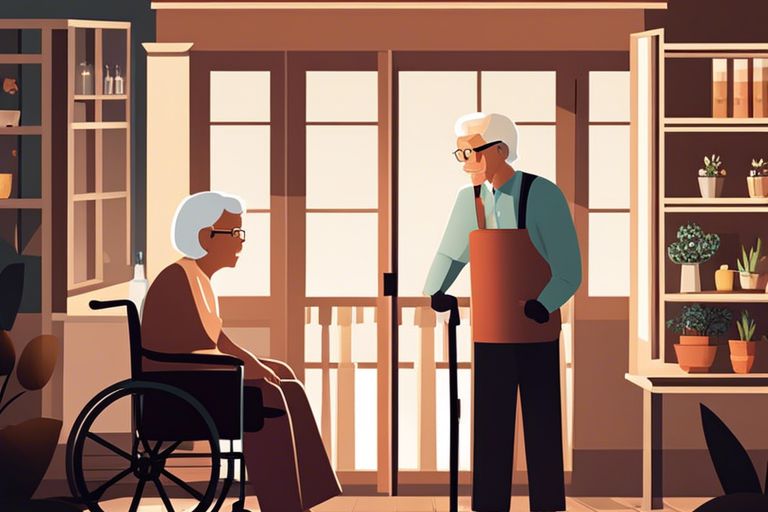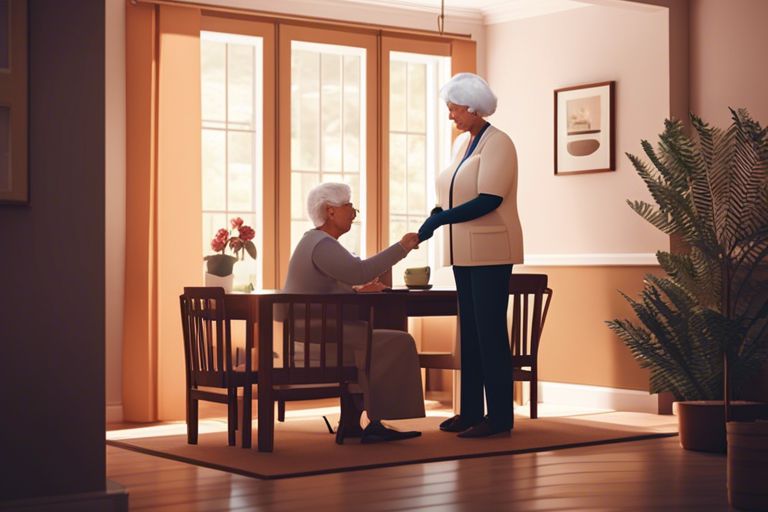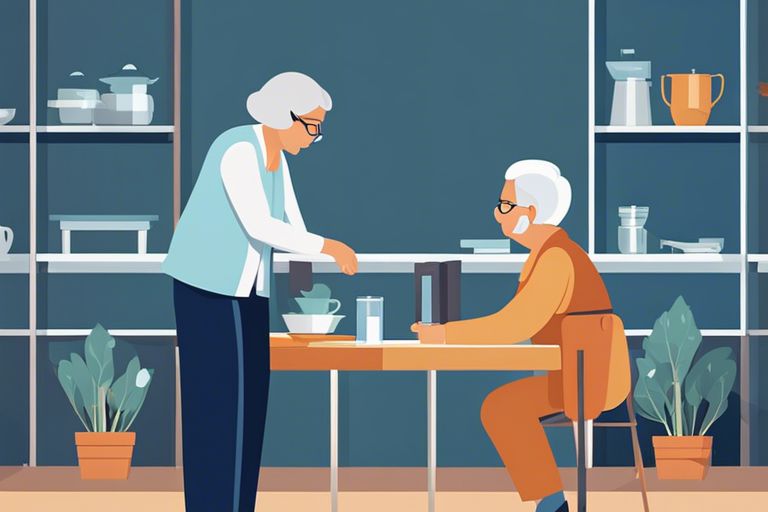Safety is paramount when it comes to caring for our senior loved ones at home. As a caregiver, it is vital to create a safe environment that promotes independence while minimizing potential hazards. From preventing falls to ensuring medication safety, this comprehensive guide will equip you with imperative tips and strategies to safeguard your loved one’s well-being in their home. Let’s explore how to create a secure and comfortable living space for seniors with the utmost care and compassion.


Identifying Hazards
While caring for seniors, it is crucial to be vigilant about potential hazards in the home that could jeopardize their safety. Identifying and addressing these risks promptly can help prevent accidents and injuries. Here are some common hazards to look out for:
Fall Risks
One of the most prevalent hazards for seniors is the risk of falls. Factors such as poor lighting, loose carpets, slippery floors, and clutter can increase the likelihood of falls in the home. To mitigate this risk, ensure that walkways are clear, install grab bars in bathrooms, secure loose rugs, and improve lighting in dimly lit areas.
Fire Hazards
To protect seniors from fire hazards, make sure that smoke detectors are installed and working correctly. Educate them about fire safety practices, such as creating an evacuation plan and knowing how to extinguish a small fire safely. Additionally, check for frayed electrical cords, avoid overloading outlets, and keep flammable items away from heat sources.
One of the most common causes of fires in seniors’ homes is unattended cooking. Encourage them to avoid leaving the kitchen while cooking and to turn off appliances when not in use. Regularly inspect stoves and ovens for any malfunctions and ensure that flammable items are stored away from the cooking area.
Poisoning Risks
Fall hazards aren’t the only risks seniors face. Poisoning is another concern, especially with medications. Ensure that medications are securely stored and properly labeled. Be aware of any potential interactions between medications and provide clear instructions on dosage to prevent accidental poisoning. Keep cleaning products and other hazardous substances out of reach and in their original containers to avoid confusion.
Hazards like poisoning can have severe consequences, so it’s crucial to take proactive measures to prevent such incidents. Conduct a thorough review of all medications in the home, including over-the-counter drugs and supplements. Educate seniors about the importance of following prescribed dosages and not sharing medications with others. Regularly dispose of expired or unused medications safely to prevent accidental ingestion.
Another critical step in preventing poisoning risks is ensuring that seniors have access to emergency contacts, such as poison control hotlines, in case of an accidental ingestion or exposure to toxic substances. Encourage them to reach out for help immediately if they suspect poisoning and know the warning signs to watch for.
Home Modifications
One of the important aspects of ensuring senior home safety is making necessary modifications to the living space. These modifications can significantly reduce the risk of falls and accidents, making the home a safer and more comfortable environment for seniors.
Bathroom Safety
Bathrooms can be hazardous places for seniors due to slippery surfaces and limited mobility. To enhance bathroom safety, consider installing grab bars near the toilet and in the shower or tub. Non-slip mats and a shower chair can also provide added stability and support for seniors while bathing.
Kitchen Safety
Home modifications in the kitchen can help seniors navigate this space more easily and safely. Consider lowering countertops to allow for wheelchair access or installing pull-out shelves for easier reach. Additionally, adding brighter lighting can improve visibility and reduce the risk of accidents while cooking or preparing meals.
The kitchen is one of the most frequently used areas in the home, making it important to ensure that it is designed with senior safety in mind. From rearranging items for easier access to installing anti-scald devices on faucets, there are various modifications that can be made to create a more functional and secure kitchen environment for seniors.
Bedroom Safety
On average, individuals spend a significant amount of time in their bedrooms, making it crucial to prioritize safety in this space. To enhance bedroom safety for seniors, consider installing night lights for better visibility at night and removing or securing any tripping hazards such as loose rugs or cords. Additionally, a bedside commode or rails can provide added support for seniors with mobility challenges.
For instance, ensuring that the path from the bed to the bathroom is well-lit and free of obstacles can help prevent falls during nighttime trips. By making simple modifications and adjustments in the bedroom, caregivers can create a safer and more comfortable environment for their loved ones.
Safety Equipment and Technology
Once again, when it comes to senior home safety, caregivers can rely on a variety of safety equipment and technology to provide peace of mind and assistance in case of emergencies. From medical alert systems to fall detection devices and home automation systems, these tools can help seniors maintain their independence while ensuring they are safe and secure in their own homes.
Medical Alert Systems
To provide an additional layer of safety for seniors living alone, medical alert systems are a valuable tool. These devices come in the form of wearable pendants or bracelets with a button that, when pressed, connects the user to a 24/7 emergency response center. In case of a fall or sudden medical issue, help can be dispatched quickly, giving seniors and their caregivers added reassurance.
Fall Detection Devices
On the topic of fall prevention, fall detection devices are necessary for seniors at risk of falls. These devices use advanced technology to sense when a fall has occurred and automatically alert emergency services if the user is unresponsive. They provide an added layer of protection, especially for seniors who may not be able to press a button in an emergency situation.
A Home Automation Systems
Home automation systems offer a convenient way to enhance senior home safety. These systems can be programmed to remotely control various aspects of the home, such as lighting, temperature, and security cameras. With the ability to monitor and adjust the home environment from a distance, caregivers can ensure that their loved ones are comfortable and safe at all times.
It is important to note that home automation systems can also integrate with medical alert and fall detection devices, providing a comprehensive safety solution for seniors aging in place. By automating certain tasks and having remote access to home controls, caregivers can have peace of mind knowing they can respond quickly to any emergency situations.

Caregiver Support and Resources
Now, caregivers play a crucial role in ensuring the safety and well-being of seniors at home. To provide the best care possible, it’s necessary for caregivers to stay informed and educated. One valuable resource is the Home Safety for Older Adults: A Comprehensive Guide 2024, which offers detailed insights and tips on creating a safe environment for seniors. This guide covers a wide range of topics, including fall prevention, emergency preparedness, and home modifications.
Training and Education
On the journey of caregiving, knowledge is power. Training and education programs can equip caregivers with the skills needed to provide better care for seniors. These programs cover various aspects of caregiving, from understanding medical conditions to learning proper lifting techniques. By investing in training and education, caregivers can enhance their confidence and ability to handle different situations effectively.
Respite Care Options
The well-being of caregivers is just as important as that of seniors. Caregiving can be demanding, both physically and emotionally, leading to burnout and exhaustion. This is where respite care options come in. Respite care provides caregivers with the opportunity to take a break and recharge while ensuring that seniors continue to receive the care they need. Respite care services can range from in-home caregivers to short-term stays at assisted living facilities.
The availability of respite care options allows caregivers to prioritize self-care and prevent caregiver fatigue. It’s necessary for caregivers to recognize when they need a break and not hesitate to seek respite care support when necessary.
Community Resources
Another valuable source of support for caregivers is community resources. Local organizations and agencies often provide services and programs specifically designed to assist caregivers. These resources can include support groups, counseling services, and information on financial assistance programs. Education on available community resources can help caregivers access the support they need to navigate the challenges of caregiving effectively.
Plus, community resources can also offer social opportunities for seniors, helping them stay connected and engaged with others in their community. By tapping into these resources, caregivers can create a strong support network that benefits both seniors and themselves.
Creating a Safe Daily Routine
Medication Management
Management of medications is crucial in a senior’s daily routine. Ensuring that medications are taken on time and in the correct dosage is vital for their health and well-being. To help with this task, caregivers can organize medication in a pillbox with compartments for each day of the week. It’s also important to keep an updated list of medications, including dosages and times, to avoid any confusion.
Meal Preparation and Nutrition
Medication and proper nutrition go hand in hand in a senior’s daily routine. Caregivers can assist in meal preparation by planning healthy, balanced meals that align with any dietary restrictions or recommendations. Additionally, it’s vital to encourage hydration and ensure easy access to water throughout the day. Regular meals and snacks help maintain energy levels and overall health.
Creating a grocery list together with the senior can also be a fun and engaging activity, ensuring that their preferences and dietary needs are taken into account. By involving them in the meal planning process, caregivers can promote independence and empower seniors to make healthy choices.
Personal Care and Hygiene
An vital aspect of a safe daily routine is personal care and hygiene. Helping seniors with activities such as bathing, grooming, and dressing can ensure their well-being and confidence. Caregivers should maintain a clean and organized bathroom with non-slip mats and grab bars to prevent falls.
Hygiene practices, such as handwashing and oral care, are crucial for overall health and can help prevent infections and illnesses. Caregivers can provide gentle reminders and assistance to ensure that seniors maintain good hygiene habits as part of their daily routine.
Emergency Preparedness
Creating an Emergency Plan
Emergency preparedness is crucial when caring for seniors at home. Your first step should be creating an emergency plan that outlines what to do in case of a natural disaster, medical emergency, or any other unexpected event. Involve the senior in the planning process, ensuring they are familiar with evacuation routes, emergency contacts, and the location of imperative items.
Essential Items for an Emergency Kit
Plan ahead and assemble an emergency kit with imperative items such as non-perishable food, water, medications, a first aid kit, flashlight, batteries, and important documents. In addition, consider including items specific to the senior’s needs, such as hearing aid batteries, mobility aids, or assistive devices.
Having a well-stocked emergency kit can make a significant difference in ensuring the safety and well-being of the senior during a crisis. Keep the kit in an easily accessible location and periodically check and replenish supplies as needed.
Staying Informed and Connected
Any caregiver should stay informed about potential emergencies in the area and have multiple ways to stay connected during a crisis. Sign up for local alerts, keep a battery-powered radio handy, and maintain a list of emergency contacts, including neighbors, family members, and healthcare providers.
Connected caregivers can quickly assess the situation, seek help if needed, and provide assistance to the senior, facilitating a smoother response to emergencies.
To wrap up
With these considerations in mind, caregivers can create a safe environment for their senior loved ones at home. By implementing simple modifications, like installing grab bars in the bathroom or removing tripping hazards, caregivers can help prevent accidents and promote independence for seniors. It’s crucial to regularly assess the home environment for potential safety risks and make adjustments as needed to ensure the well-being of our elderly family members.
Note, safety is a top priority when caring for seniors, and with the right knowledge and preparation, caregivers can make a significant impact on their loved one’s quality of life. By following the tips and guidelines outlined in this complete guide for caregivers, we can create a secure and comfortable space where seniors can thrive and age gracefully in the comfort of their own homes.
FAQ
Q: Why is senior home safety important?
A: Senior home safety is crucial to prevent falls, accidents, and injuries that can have serious consequences for elderly individuals.
Q: What are some common hazards in the home for seniors?
A: Common hazards for seniors at home include slippery floors, loose rugs, poor lighting, cluttered pathways, and lack of grab bars in bathrooms.
Q: How can caregivers improve senior home safety?
A: Caregivers can improve senior home safety by making modifications to the home environment, installing safety equipment, and providing assistance with daily activities.
Q: What should caregivers consider when evaluating senior home safety?
A: Caregivers should consider the senior’s mobility, vision, hearing, cognitive abilities, and any existing medical conditions when evaluating home safety.
Q: What are some tips for preventing falls at home?
A: To prevent falls at home, caregivers can remove tripping hazards, install grab bars and handrails, ensure proper lighting, and encourage the use of mobility aids.
Q: How can technology help improve senior home safety?
A: Technology such as medical alert systems, motion sensors, video monitors, and smart home devices can help caregivers monitor seniors and respond quickly in case of emergencies.
Q: When should caregivers seek professional help for senior home safety?
A: Caregivers should seek professional help for senior home safety if they are unsure about making home modifications, need assistance with caregiving tasks, or if the senior has complex medical needs requiring specialized care.

